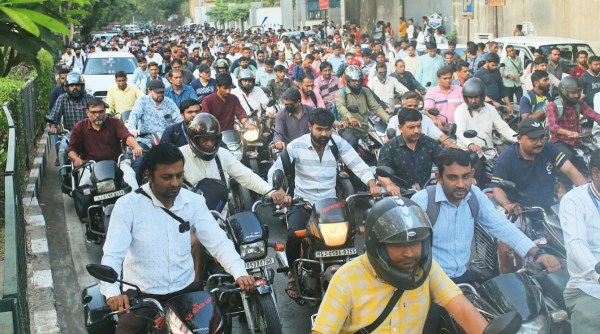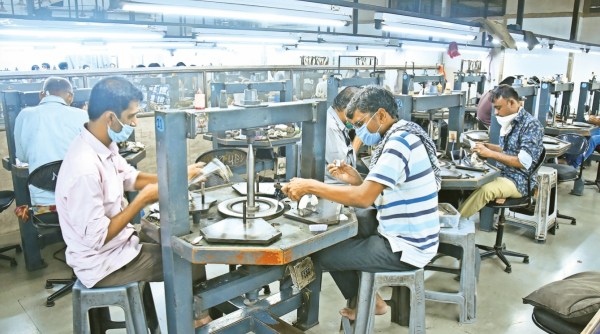Last week, around 350 of the thousands of workers at Laxmi Diamonds, a cutting and polishing factory in Surat’s Varachha, called a protest demanding a salary hike and pay vacation.
Owned by the Gajera brothers, the factory had declared a summer vacation from May 5 to May 28. But the workers were called back, and the factory resumed functioning on May 22. Hundreds, however, took to the streets on Thursday as they sought pay for the vacation period and a hike.

The protesters called off the stir and joined work on Friday only after the Diamond Workers Union Gujarat’s Surat zone president Bhavesh Tank mediated. The truce came as factory owner Chuni Gajera committed to addressing their issues.
Usually the factory owners, Tank told The Indian Express, would give a raise of Rs 1,000-1,500 annually to workers. “In January, the owner of Laxmi Diamonds had given assurance that the workers would get a raise but the promise was not delivered. The diamond workers also demanded vacation salary from May 5 to May 22. We intervened and came out with an amicable solution. We are convinced the diamond polishers that seeing the present situation, the owners are also facing financial problems as there is not a major demand for polished diamonds in the international market. We ensured the owner’s commitment and assured the workers. Later they agreed to resume work Friday morning onwards,” he explained.
 Diamond polishers leave after a day’s work from a factory at Varachha. Hanif Malek
Diamond polishers leave after a day’s work from a factory at Varachha. Hanif Malek
Challenges
As per rough estimates, of every 11 diamonds in the world, eight are polished in Surat. Deeply invested in the luxury product whose market has been gradually reviving following the pandemic, the city is apparently staring at a recession, this time owing to the Russia-Ukraine conflict that began last year. Many factory owners, due to the conflict, declared an unexpectedly longer summer vacation of 20 to 25 days. This was double the usual 5 to 10 days.
Several factory owners had to cut short working hours to control production as the supply of rough diamonds was low on account of the sanctions by the United States on Russia’s state-run diamond mines announced in April.
Migration stories
The diamond manufacturing and trading industry in Surat is dominated by migrant Patidars, originally farmers from Saurashtra, and Jains mainly from Palitana in Bhavnagar and Palanpur in Banakantha.
They started working in a few diamond factories. The Jains got involved in the trading of polished and rough diamonds. However, currently, there are more Patidars than Jains in the trading and manufacturing of diamonds.
Surat has over 15 lakh migrants from Saurashtra and nearly a tenth of the city’s population of about 80 lakh is estimated to be engaged with the diamond industry, roughly contributing around 35 per cent to the city’s economy. The diamantaires also run various charities in the city.
Kanjibhai Bhalala, a social worker and president of Surat’s Saurashtra Patel Sewa Samaj, says, “Of the 15 lakh people, eight lakh people are invested in the diamond industry and remaining are into other businesses and sectors including real estate, textiles and embroidery and IT . They are mainly settled in Varachha and Katargam areas and other areas such as Kamrej, Velanja and Pasodara. Varachha District Cooperative Bank has 22 branches with over five lakh account holders in Surat City and most of them are Saurashtrians. The bank has recently completed 26 years.”
The Saurashtra migrants are “so embedded in Surat that they have five MLAs and 30 corporators in the Surat Municipal Corporation,” says Bhalala. “They are politically and financially powerful and are spread in all kinds of businesses in Surat city. People associated with the community run a Blood Bank, Kiran Hospital (1,000 beds), and other hospitals, a deemed university, a medical college, and libraries. They flourished in Surat city and tend to give back to society, thereby playing an important role in the development of the city,” he says.
One such story of migration is that of the Surat Diamond Association (SDA) president Nanubhai Vekariya.
 Men at work at a diamond polishing unit in Surat. Hanif Malek
Men at work at a diamond polishing unit in Surat. Hanif Malek
From Haripar village in Amreli of Saurashtra, Vekariya, a Leuva Patidar, came to Surat in 1965 when he was just 14. Dropping out of school after Class 7, he began to work at a diamond factory. “At that time, there were around 40 diamond-cutting and polishing units in Surat and the city’s population was around 3 lakh. After working for five years, I started a small factory in 1971 with four emery wheels, and 18 workers. Till 1985, before wrapping up the manufacturing business, there were 100 emery wheels, and around 500 people working in my factory. I then switched over to trading activities seeing a good profit. Today, I have my trading office in Surat and in Mumbai at Bandra Kurla Complex. My annual turnover of a diamond trading business is around Rs 25 crore,” says Vekariya.
He added, “Presently there are around 5,000 small, medium and big diamond units in Surat that employ over six lakh diamond workers. The business is export-oriented and profit-making. The money also gets invested in real estate and textile sector and other sectors. In my view, the diamond industry has contributed over 35 per cent in the total economy of Surat city.”
Falling in the unorganized sector, however, there is no real data on the number of factories and people associated with it.
Aftermath
According to Vekariya, during the Covid pandemic, the diamond industry faced huge challenges and factories closed down. “This resulted in the migration of lakhs of people from this industry to their native places in Saurashtra and north Gujarat. Post Covid, the diamond business flourished, and people earned more. However, after the Russia-Ukraine war, the diamond factories faced a shortage of supply of rough diamonds. When the war began, the rough diamonds imported from Russia were around 25-30 per cent. Over the last two months, it has fallen to 5-7 per cent,” he explains. “This is because there is no demand for polished diamonds in the international market has diminished.”
Another challenge is linked to the pandemic. “People in the US stayed at home without work and they got allowances from the government. With less to spend, they saved a lot of money and invested in buying jewelery items. However, now there is no major sale in the American market and other European countries, which has directly affected the diamond industry of Surat. If this continues for the next few months, the industry will face drastic problems, as was seen in the recession of 2008. We are hopeful of the Christmas sale and have kept our fingers crossed,” Vekariya said.
Vekariya claims the owners independently declared vacations to “control the production” and denies that there were any layoffs. Because of the slump on account of the war, “over 20,000 diamond workers became jobless”, says Tank, adding that many migrated many to their native places and others took to petty jobs.
“There are over 300 small units in Surat that declared unofficial vacations in the summer which is unusual. These diamond polishers are struggling for survival. We have given a memorandum to the district collector letter demanding that the state government should announce a financial package for the diamond workers and a scheme to help them.”
The war also led to a dip in the exports of polished diamonds.
Ramesh Vaghasia, a diamond factory owner, said the price of rough diamonds had also risen. “After Covid, from 2022 to 2023, there was major demand in the industry. Diamonds that sold for Rs. 20,000 per carat before Covid sold for Rs. 30,000 per carat after the pandemic, and now it has dropped to Rs 26,000 per carat. After the Ukrainian war, sales have gone down to 30 per cent. We are also putting our fingers crossed for the next Christmas sale.”
Journey of a diamond
Letters of imports of its rough diamonds from Canada, Australia, Antwerp, South Africa, Russia, and Dubai. After cutting and polishing, 60 per cent of the finished diamonds are exported to the US, and the remaining to European countries, China, and the Middle East, says a veteran letter, who has spent 30 years in the business, on conditions of anonymity .
Former Gujarat region chairman of Gems and Jewelery Export Promotion Council (GJEPC) Dinesh Navadiya shares, “Prior to the Ukraine-Russia war, the supply of rough diamonds from Alrosa mines of Russia was 29 per cent and today it has gone down to seven per cent. The reasons are the US sanctions on Russia’s diamonds and other products.”
Prior to the ongoing war, Russia was selling its rough diamonds sourced from the government-owned Alrosa mines in the Yakutia province worldwide. Experts in the industry say that with the sanctions by the US, European and other countries have also boycotted the purchase of rough diamonds from Russia.
Russians roll out the red carpet
On May 16, a government delegation from the Yakutia Russian province in the Republic of Sakha came to Surat and rolled out the red carpet of sorts for the diamond During meetings with the GJEPC (Gem Jewelery Export Promotion Council), the Russians invited them to set up diamond-cutting and polishing factories in the Free Trade Zone of their province.
They also lured the diamond industry to open factories in Russia where they could source good quality rough diamonds directly from the mines.
The delegation also promised no tax burden and visa-on-arrival for diamond factory workers. Experts say the reason for the visit may be linked to the downfall in the sales of rough diamonds from Alrosa mines.
“The Russian delegation had invited us for a visit to see the infrastructure and other facilities provided by them for setting up diamond factories. Presently, the industry is passing through a bad phase and there is no possibility of investments. We have sent the message of the Russian delegation to the industrial folks in Surat and sought their interest. But to date, nobody has come up with a positive response. Once the war ends and normalcy returns, then seeing the situation, the industry will make its first step towards investing in Russia. The USA is currently going through a recession period,” Vijay Mangukiya, GJEPC chairman of Gujarat region, shares.
‘Dream’ diamond bourse
While the government plans to transfer the diamond trade from Mumbai to Surat at the swanky diamond bourse coming up in Khajod, the industry could face odds if the war persists, leading to more factories closing down.
Surat diamond bourse complex, a major diamond trading center, is ready for inauguration at Dream City in the Khajod area. The construction cost of this project is estimated to be around Rs 3,200 crore with nine towers each of 15 floors. There are over 4,500 offices that have already sold out to the diamond merchants of Surat and Mumbai.
Sources said there were many diamond traders from Mumbai who had also purchased shops in the Surat Diamond Bourse to expand their business. When trading began, after cutting and polishing, Surat could become a hub of the trading of diamonds as well.
Today, a majority of the diamond factories of Surat have their trading offices in BKC (Bandra Kurla complex) and other areas in Mumbai.
Apart from this, many diamond and jewelery manufacturers from Mumbai had also expanded their business by starting up diamond and jewelery factories in the jewelery Special Economic Zone in Surat at Sachin. “Surat city is waiting to get international air connectivity and once it starts, the diamond industry will slowly move from Mumbai to Surat,” said an expert.
